Breeds of beef cattle in Ontario
Learn about the different breeds of beef cattle. This technical information is for commercial beef producers in Ontario.
ISSN 1198-712X, published September 2001
Breed comparisons
The environments and resources available to raise beef cattle are as varied as the breeds themselves. Table 1 groups breeds into biological types for four criteria. The table is based on extensive research performed over more than 25 years at the Meat Animal Research Centre in Clay Centre, Nebraska. Notice the tremendous variability in the available breeds.
The table will help you compare breeds and rank them according to criteria important to your herd and market, whether it is reproduction, growth, carcass traits or a combination of them all. More information is available on a breed-average basis for individual traits than is presented here, but a large degree of variability can exist within a breed. Breeding decisions involve individual animals, not breed averages, so selection of the right individuals within a breed is critical. Use the information presented here to familiarize yourself with available breeds and narrow down your choices. Selection of individual animals for a breeding program will require analysis of the individual's genetic merit for the traits of interest. Breed differences can be blamed for product inconsistency, but they can also be exploited to produce adapted animals and a consistent product.
| Breed | Growth rate and mature size | Lean to fat ratio | Age at puberty | Milk production |
|---|---|---|---|---|
| Jersey | X | X | X | X X X X X |
| Longhorn | X | X X X | X X X | X X |
| Herf-Angus | X X X | X X | X X X | X X |
| Red Poll | X X | X X | X X | X X X |
| Devon | X X | X X | X X X | X X |
| Shorthorn | X X X | X X | X X X | X X X |
| Galloway | X X | X X X | X X X | X X |
| South Devon | X X X | X X X | X X | X X X |
| Tarentaise | X X X | X X X | X X | X X X |
| Pinzgauer | X X X | X X X | X X | X X X |
| Brangus | X X X | X X | X X X X | X X |
| Santa Gert. | X X X | X X | X X X X | X X |
| Sahiwal | X X | X X X | X X X X X | X X X |
| Brahman | X X X X | X X X | X X X X X | X X X |
| Nellore | X X X X | X X X | X X X X X | X X X |
| Braunvieh | X X X X | X X X | X X | X X X |
| Gelbvieh | X X X X | X X X X | X X | X X X X |
| Holstein | X X X X | X X X X | X X | X X X X X |
| Simmental | X X X X X | X X X X | X X X | X X X X |
| Maine Anjou | X X X X X | X X X X | X X X | X X X |
| Salers | X X X X | X X X | X X X X X | X X X |
| Piedmontese | X X X | X X X X X | X X | X X |
| Limousin | X X X | X X X X X | X X X X | X |
| Charolais | X X X X | X X X X X | X X X X | X |
| Chianina | X X X X | X X X X X | X X X X | X |
*From Cundiff et al., 1993 BIF Proceeding
**Increasing number of X's indicate relatively higher values.
Factors in selection
A number of factors must be considered when selecting breeds for either a seedstock or a commercial program. Among these are:
- individual breeding goals
- environment
- quantity and quality of feeds available
- cost and availability of good seedstock
- how breeds will complement each other in a crossing program; and
- market-specific breed combinations may command market premiums.
If selecting breeds for a crossbreeding program note that scientists involved in breed evaluation research generally recommend a 50/50 mix of British and Continental breeding for the cow herd for most of North America, excluding subtropical areas. Limited feed resources indicates a higher percentage of British breeding. Where abundant feed resources are available and/or maximum lean yield is desired, a higher percentage of Continental breeding is recommended. For more information on crossbreeding see OMAFRA Factsheet Crossbreeding Systems for Beef Production, Order No. 01-011.
Common breeds of beef cattle in Ontario
A brief overview of the history, physical characteristics and dominant traits of the beef cattle breeds common to Ontario follows. The breeds in this section have substantial numbers in both purebred and commercial operations and have undergone substantial selection programs over the years. The breeds listed offer the genetics and selection required to develop a breeding program suitable for the available market.
Angus
The Aberdeen Angus breed existed in Scotland 400 years ago and evolved during the 19th century in northeast Scotland in the counties of Angus and Aberdeen. The first Aberdeen Angus was imported into Canada in 1860.
Angus cattle are solid black or red and are polled. Both colours are registered in the Canadian Angus Association herd book. Angus are noted for good maternal qualities and a high carcass quality. Angus cattle are also recognized for their ability to forage under rugged conditions.
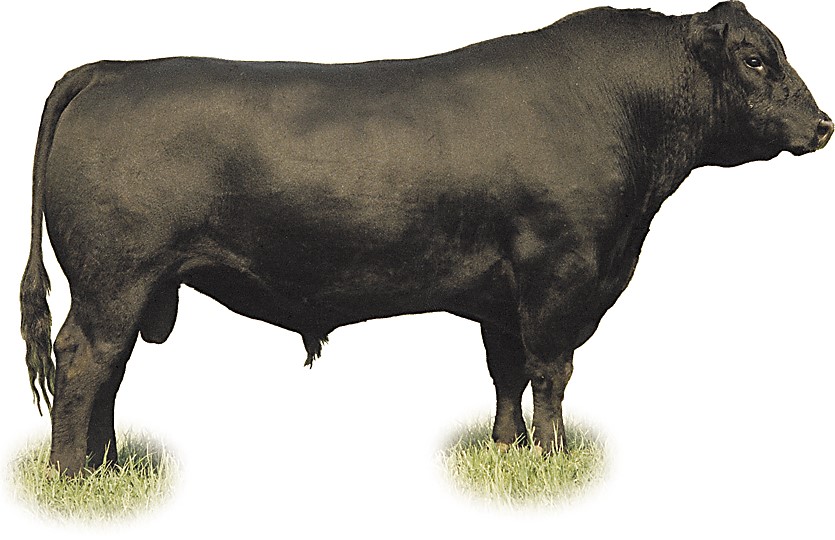
Figure 1. An Angus bull.
Blonde d'Aquitaine
Blonde d'Aquitaine originated in the southwest of France, where they developed as a dual-purpose breed. Animals are cream to fawn coloured. The breed is horned and recognized primarily for its beef characteristics and high yielding carcasses. The first Blondes were introduced into Canada in 1971.

Figure 2. The Blonde d'Aquitaine.
Charolais
Charolais, one of the oldest French breeds and the earliest European import into Canada, arrived from the U.S. in 1955 and from France in 1967. Originally, Charolais were used for meat, draft and milk, but have since become specialized as a beef breed. Cattle of the Charolais breed are large and heavy, white to cream-coloured and either horned or polled. Through sire evaluation and breed improvement, they offer the beef industry hardy cattle with rapid growth and good muscling.
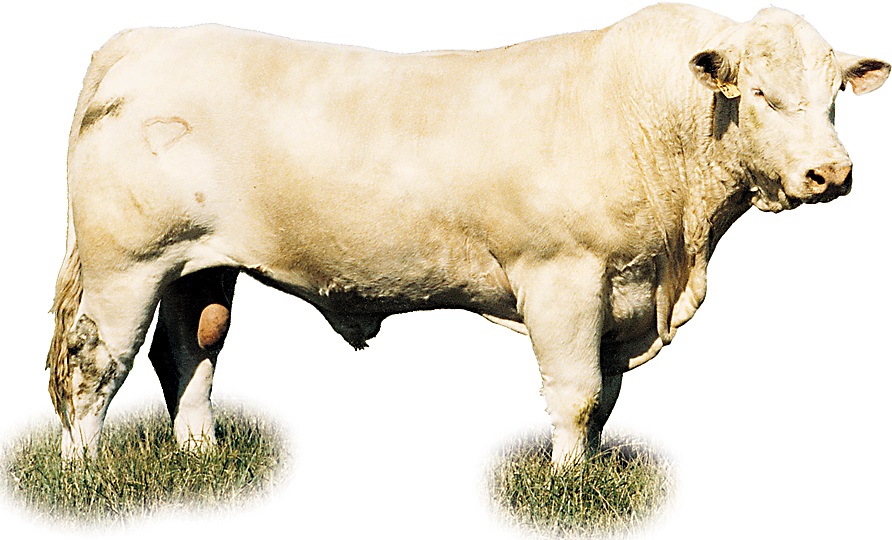
Figure 3. A Charlolais bull.
Gelbvieh
Gelbvieh or German Yellow Cattle evolved in the early 19th century through the crossing of various breeds in northern Bavaria. This produced a growthy dual-purpose animal that also served as a draft animal. Gelbvieh have been in Canada since 1972. Emphasis in North America in recent years has been on meat production.
The Gelbvieh is solid-coloured, reddish gold to russet, with fine dense hair. They have good size, heavy muscling and are known for their desirable carcass and strong maternal characteristics.

Figure 4. A Gelbvieh bull.
Hereford
The Hereford, one of the oldest cattle breeds, was developed in Herefordshire, England. First importations into Canada were in 1860.
The Hereford is a reddish-brown colour with white on the head, brisket, chest, underpart of the body, lower legs and tassel. The white face is a dominant characteristic. Herefords can be either horned or polled.
Hereford cattle are extremely hardy and show excellent foraging ability. Among beef breeds, they are not high milk producers but have good growth potential and calve relatively easily. Their popularity is shown by their continued use as a beef-producing animal that crosses well with other breeds. Bulls are usually docile and easy to handle.

Figure 5. A Hereford bull.
Limousin
The Limousin originated in the hill country of south-central France. The cattle range from a golden wheat colour in the females to a deep red-gold in the males, darkening somewhat with maturity and age. The Limousin has always been selected for its meat qualities. Referred to as the "carcass breed," Limousins do well in carcass competitions with their large rib eyes and high yielding, quality, lean carcass.
Cows are also noted for their calving ease and mothering ability. Limousins were introduced into Canada from France in late 1968.

Figure 6. A Limousin bull.
Maine-Anjou
The Maine-Anjou is one of the largest breeds of cattle in France. They were developed in Brittany when stock that existed in the area before 1850 were crossed with imported Shorthorns to produce a superior animal. The breed is large, horned, and is dark red, usually with a white underline and often with small white patches on the body. The appeal of this breed to cattle producers is their high growth rate, milking ability and good disposition. Lean carcass quality and high cutability also put them in demand.
The breed was first imported into Canada in 1968.
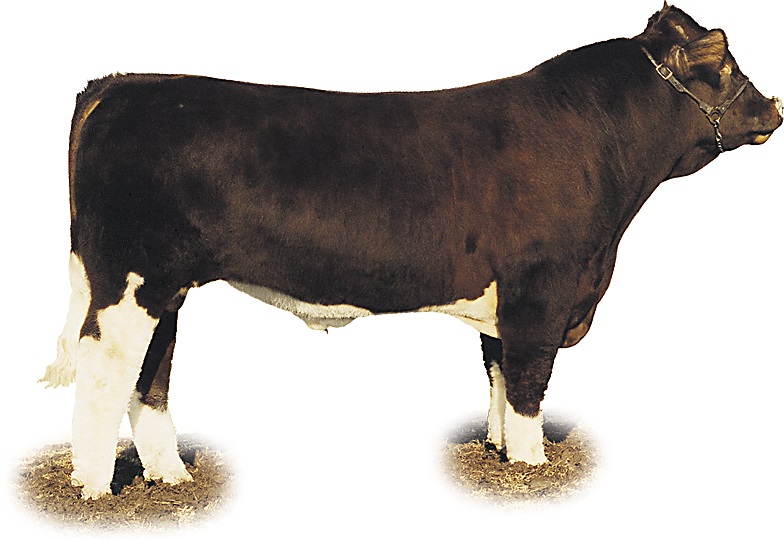
Figure 7. A Maine-Anjou bull.
Shorthorn
The Shorthorn originated in the counties of Durham, Northumberland and York, England. First importations into Canada took place in 1825. The Shorthorn has been called the Foundation breed since it has been used in the development of 30 or more exotic breeds throughout the world.
Shorthorns may be red, white, roan or any combination of red and white. Cattle are either horned or polled. The breed acquired a reputation for hardiness, mothering ability, and good temperament. The major development of the breed has been for beef production, although dual- purpose herds for milk production are being maintained.
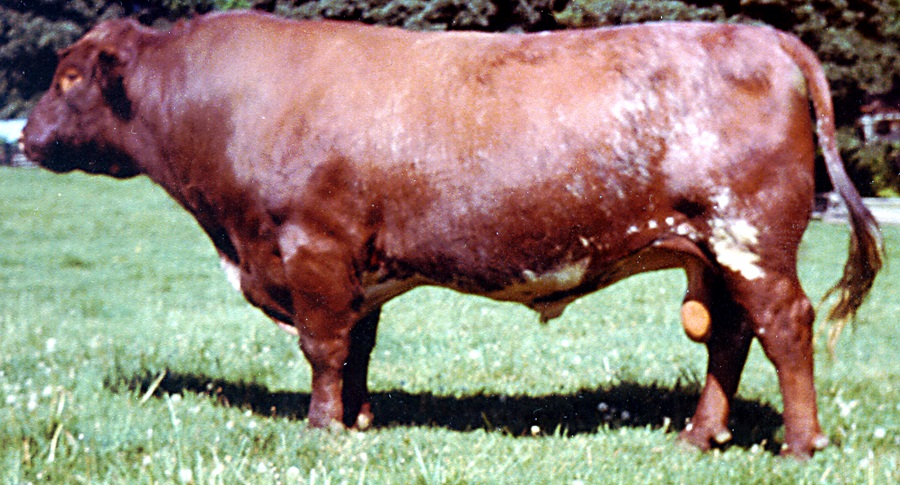
Figure 8. A Shorthorn bull.
Simmental
The Simmental originated in Switzerland during the Middle Ages. Although developed as a triple purpose meat/draft/milk animal, they are now considered a dual purpose milk and meat producer. Simmentals range in colour from light tan to dark red with white markings on the head, behind the shoulders, belly, legs and flank. They can be horned or polled.
Simmentals are noted for their muscling, high growth rate and high milk production. Simmental cows usually wean heavy calves due to their high milk production and the breed's high growth potential. First imports into North America were in 1967.
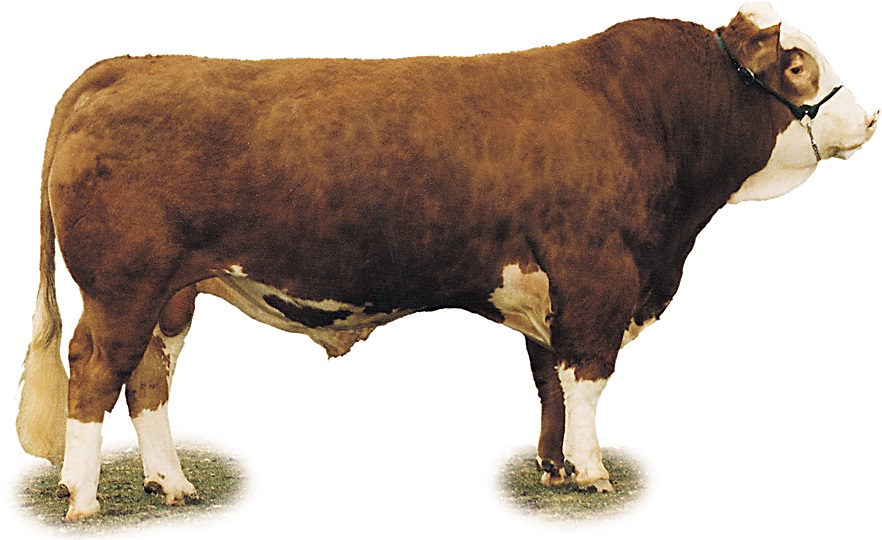
Figure 9. A Simmental bull.
Other breeds of beef cattle in Ontario
There is limited availability of purebred seed stock from the breeds listed in this section due to the small number of breeders and purebred stock in Ontario. Several of the breeds are used in crossbreeding programs for specific traits. The double-muscled breeds are often bred to the low end of dairy herds to increase meat yield and marketability of veal calves. Breeds known for their calving ease can be used on heifers, and include Salers, Murray Grey and Galloway. If considering one of the following breeds it is important to understand where they fit in the Ontario market, what market opportunities are available and whether or not seed stock can be located and purchased.
Belgian Blue
Belgian Blues are the third largest and perhaps fastest growing beef breed in Great Britain. First introduced to Canada in 1976, it is one of the highest yielding beef breeds. The breed's attributes include double-muscling, fine bones and quiet temperament. Dairy producers are making use of Belgian Blue semen to raise beef-type calves from the bottom end of their dairy herds.
Chianina
The Chianina breed of cattle is of ancient origin, going back to the Roman era when they were used as draft animals. These cattle derive their name from the Chiana Valley in Italy. It is one of the largest breeds of cattle in the world with weights up to 4,000 lbs. The animals are tall, long-legged, long bodied and heavy. Mature bulls are 6 feet tall and are higher at the back. They have white hair and black skin, and adapt well to hot climates.
Chianina are noted for rapid growth rate, leanness, high dressing percent and calving ease. First importation into Canada occurred in 1971.
Galloway
Galloway is an older breed, developed in southwestern Scotland. They have not experienced the extreme breeding for type that other breeds have. They were originally imported from Britain into Canada in 1861.
Three separate breeds of Galloway exist; Galloways, Belted Galloways and White Galloways. They are registered in the same herd book but in 3 separate sections. Three colours are registered: black, dun and red. All Galloways are polled and are noted for their hardiness, maternal traits, calving ease and foraging ability. Their double hair coat allows them to thrive year round in the harshest climates, requiring minimal shelter.
Highland
Highland cattle originated in the Highlands and west coastal area of Scotland. They were first imported into Canada in the 1880's. The breed is horned and can be black, brindle red, yellow, white or dun in colour.
The breed will survive and reproduce under extreme climatic and poor grazing conditions. It is known for its browsing ability. The double coat consisting of a downy undercoat and long outer coat that can reach 13 inches is well oiled to shed rain and snow. They are slow maturing and noted for longevity.
Murray Grey
The Murray Grey cattle originated in Australia and were introduced into Canada in 1969. The breed resulted from the chance mating in 1905 of a light roan, nearly white Shorthorn cow to a purebred black Angus bull, producing a calf that was silver grey in colour. The same cow produced 12 calves, all grey, by various Angus bulls. From 8 females of these naturally polled grey calves the colour remained dominant in their progeny although Angus bulls were used exclusively.
The breed has a reputation for calving ease, mothering ability, hardiness and a docile temperament. They are easy keepers, can finish on grass and have a high carcass cutability.
Parthenais
The Parthenais breed existed in Western Europe for hundreds of years with the official French herdbook being established in 1893. The Canadian herdbook was established in 1993 following the first importations of embryos and semen in 1991. Parthenais are docile, reddish buckskin cattle with black pigmentation. They are highly productive, fertile producers known for their high cutability and heavily-muscled carcass.
Piedmontese
The Piedmontese is considered a double-muscled breed, which is native to only a small section of northwest Italy in the Alps. Importations into Canada were delayed because the national breed association in Italy refused to sell breeding stock until 1980.
Piedmontese are fawn in colour, gradually turning white with black skin pigmentation. The breed is considered to be fully double-muscled, with none of the difficulties traditionally associated with this characteristic, and are noted for their quality, lean carcass, high cutability and calving ease.
Pinzgauer
The Pinzgauer belongs to a group of European cattle breeds that are indigenous to the Alpine regions of Austria. They are considered a dual-purpose breed. The first Pinzgauers arrived into Canada in the early 1970's.
The hair colour of the Pinzgauer cattle is chestnut brown having a range of light to dark brown with a clearly defined white stripe of varying width along the back and loins. The breed is of medium size, horned, with a gentle temperament. Pinzgauer are known for their longevity, fertility and mothering ability.
Red Poll
Red Polls existed as a prehistoric breed in Europe. The Danes introduced them into England. Two strains, the Norfolk and Suffolk, were crossed in 1808 to combine fleshing qualities and milking qualities, respectively. This was the origin of the Red Poll breed that was introduced into Canada in the early 1880's.
The breed is red in colour, small to medium in size and polled.
Salers
This breed was developed in south-central France in the rough mountain region of Salers. The cattle are a solid, deep cherry red, varying somewhat in intensity and horned. A small number are black and polled animals are rare. Salers were first brought into Canada in 1972.
Salers were originally bred for milk, meat and draft purposes. The breed now is primarily raised for meat production. They are known for their maternal qualities of easy calving and milk production and their ability to forage and tolerate extremes in climate.
South Devon
The South Devon breed was developed in the southern part of Devonshire, England. Originally a draft type these cattle were selected for both milk production and fleshing quality during the 19th century.
South Devon's are the largest of the English and Scottish breeds. These cattle are a solid bright yellowish red, varying slightly in shade and often having a somewhat mottled appearance. The cattle are horned and noted for hardiness, good milk yield and their lean carcass quality.
South Devon cattle were introduced into Canada in 1969 direct from England.
Tarentaise
The Tarentaise is one of the old breeds indigenous to the Alpine regions of southeastern France. It is a hardy, well-adapted mountain type that has survived to the present without any particular infusion of other breeds.
Tarentaise are a moderate-sized animal, early maturing and usually reddish tan in colour, with dark pigmented skin. The breed is horned and had been primarily selected for milk production, although they have been selected for beef characteristics since their importation into Canada in 1972.
Welsh Black
The Welsh Black are descendants of cattle raised and domesticated in the rugged Welsh mountains of ancient Britain before the Roman Conquest in 55 B.C.
Welsh Black cattle are medium in size, horned, black in colour and have thick soft and fairly long hair that is shaggy in winter. They are known as a maternal breed with gentleness, hardiness, milking ability and foraging ability.
The first Welsh Black were purchased in the U.S. in 1968 and the first direct importation from Wales was in 1971.